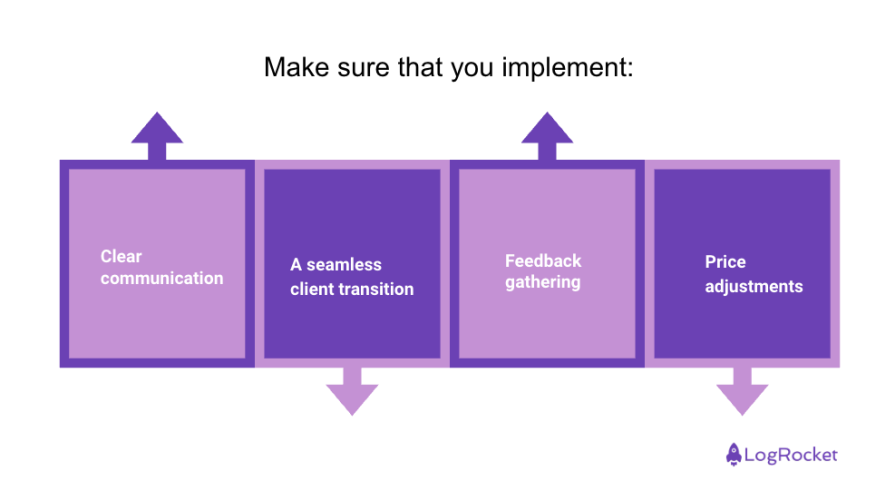In the sales world, it’s a common practice to bundle more than one product or service together and offer them for a reduced fee. This can be a great, consumer-friendly opportunity as long as your users actually need all the things you sign them up for. However, more often than not, bundles include dead weight.

For instance, it used to be the case in Poland that you could only get cable TV if you ordered it with a landline telephone. To make matters worse, whole industries offer similar bundles to extort customers and cover the cost of maintaining the less popular product in the portfolio.
That said, this creates an obvious opportunity. By breaking from this sales model and adopting unbundling, you can offer your users the ability to pay for what they actually want and need. This lets them receive more value from your product and increases their trust in you.
Keep reading to learn more about unbundling, including how to implement it, the associated challenges, and examples of successful companies.
Unbundling involves breaking down a product or service into its individual components, allowing customers to purchase only what they require. This approach has become increasingly relevant in product management as companies strive to enhance customer satisfaction, streamline offerings, and foster innovation.
Companies tend to opt for unbundling both digital and physical products to cater to diverse customer preferences, reduce complexity, and stay competitive. By offering modular options, you can tap into new market segments, adjust pricing strategies, and differentiate yourself in saturated markets.
When it comes to product management, unbundling matters for two key reasons:
Unbundling offers your customers the ability to choose exactly what they need without paying for unnecessary features. It can be a way to differentiate yourself in the market and earn your customers’ trust early on. Expect users to be pleasantly surprised when you don’t try to hit them with a costly bundle.
By offering individual components, you can reduce the complexity that comes with bundled offers. When you break products free from bundles, it becomes easier to track usage data and determine which ones to sunset. Sometimes users use products just because they have them, not because they actually like them.
To give you a better sense of unbundling, pay attention to how these companies leveraged it to focus development efforts and bring more value to users:
Microsoft transitioned from selling its Office suite as a single package to offering individual applications like Word, Excel, and PowerPoint separately. This move allowed users to purchase only the software they needed, increasing accessibility and catering to a wider audience.
At the same time, users can still buy the whole suite in a discounted bundle or use it on a subscription model depending on their use case.
Originally a subscription-based DVD rental service, Netflix unbundled its offerings by separating its streaming service from its DVD rentals. This strategic move allowed the company to focus on the burgeoning streaming market, leading to significant growth and market disruption. This was super crucial in terms of achieving the right company’s focus, as DVD rentals were slowly dying with the growth of online offerings.
Many airlines have unbundled services that were traditionally included in the ticket price, such as checked baggage, in-flight meals, and seat selection. This approach enables airlines to offer lower base fares and allows customers to pay only for the extras they value.
However, while this move opened air travel to the masses, making luggage an additional cost can leave customers feeling scammed. It’s important to find a balance and determine a list of essential features that need to be in the base offering.
In the tech world, bundling services is as common as coffee shops offering free Wi-Fi. It’s convenient for users and creates a seamless ecosystem. Microsoft took this route by integrating Teams into its Office 365 suite. It looked like a beneficial strategy, as 365 customers were given almost every tool possibly needed to run a modern company.
However, Slack, a major Teams competitor, filed a complaint with the European Commission in 2020. It argued that Microsoft’s bundling of Teams with Office 365 was anti-competitive, making it unfair for other collaboration tools to compete. In other words, Slack might’ve been a superior product, but it would lose with Teams due to financial practicality.
The European Commission took these claims seriously, launching an antitrust investigation. It was set to determine whether Microsoft’s bundling practice was stifling competition and limiting choices for consumers and businesses in the EU.
Facing increasing legal pressure and the possibility of large fines, Microsoft decided to act before a verdict was reached. It announced that Teams would no longer be included by default in its Office 365 and Microsoft 365 suites in the European Economic Area and Switzerland. Instead, Teams would be offered separately at a lower price for customers who still wanted to add it to their suite.
This example shows that, whether by choice or force, unbundling is a client-friendly option, that promotes a competitive market.
Unbundling doesn’t present major challenges but keep an eye out for the following:
As a PM, you play a key role in implementing an unbundling strategy. To get started, make sure that you implement:

Make sure to describe the benefits of each unbundled component clearly. This involves educating customers on how individual offerings meet their specific needs and providing transparent pricing. Also, it would be great to come up with the right message to the clients, so the company doesn’t admit that previous bundles were anti-consumer and the company had a “change of heart.”
Even when products are unbundled, it’s crucial to maintain a cohesive brand experience. This can be achieved by ensuring that all components are compatible and deliver consistent quality. Also, consider what to do with existing users: should you push existing users to unbundle their purchase and select the components they need, or should they stick to current bundles if they are happy with them?
Regularly reach out for customer feedback to understand their preferences and pain points. Use this information to refine offerings, adjust pricing, and enhance features. Perhaps the bundles are still the way to go but with fewer products or services offered together?
Develop pricing strategies that reflect the value of individual components while remaining competitive. Consider tiered pricing, subscriptions, or pay-per-use models.
Unbundling offers a pathway to create adaptable and user-focused products. By breaking down offerings into individual components, you can better meet customer needs, foster innovation, and stay competitive in dynamic markets.
Give your users what they want and don’t try to trick them into buying something they don’t need. Comment any questions you have and come back for the next article.
Featured image source: IconScout

LogRocket identifies friction points in the user experience so you can make informed decisions about product and design changes that must happen to hit your goals.
With LogRocket, you can understand the scope of the issues affecting your product and prioritize the changes that need to be made. LogRocket simplifies workflows by allowing Engineering, Product, UX, and Design teams to work from the same data as you, eliminating any confusion about what needs to be done.
Get your teams on the same page — try LogRocket today.

A practical framework for PMs to use AI in ideation without sacrificing judgment, strategy, or decision quality.

A practical five minute revenue estimation method to help product managers compare ideas, drop low impact features, and prioritize smarter.

A practical guide for PMs who want to stop being bottlenecks, delegate smarter, and lead teams effectively with a clear ownership framework.

Stop letting unreliable data block features. Treat data as inventory to track quality, ownership, and ship with confidence.